7 Types of Content (& How to Use Them) for SEO
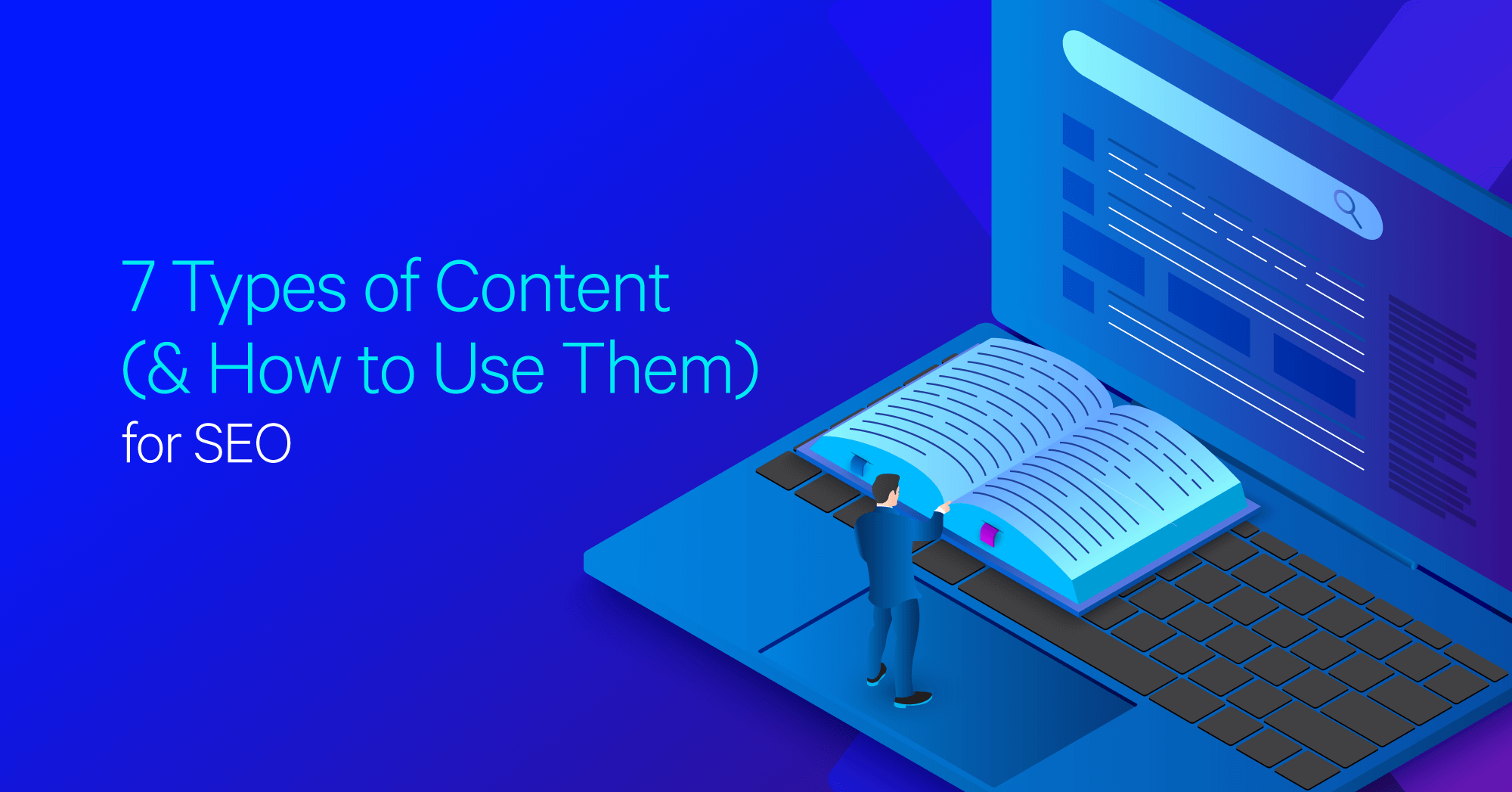
Hand off the toughest tasks in SEO, PPC, and content without compromising quality
Explore ServicesWhen it comes to SEO and digital marketing, content makes the world go round.
Just about every strategy and campaign will rely on one of the many types of content you can find online. One of the benefits of content marketing is being able to connect to different customers in different ways.
That is why content marketing is important. It’s important to know all the different types of digital content so you know which will work best for connecting with each group of customers. It also helps you use the best content for each level of the sales funnel online.
Want to know more? We wrote this guide on the different varieties of content you can create and how to use them most effectively.
What is SEO Content?
SEO content refers to content that is optimized so people can more easily find it on search engines.
When someone searches for a topic on Google that relates to your business, you write SEO content so they see it at the top of the search results.
The purpose of SEO content is to attract more potential customers to your website by creating great content that they’re searching for.
When we talk about SEO, we mean Google especially since they still dominate the global search market (sorry Bing).

In 2019 (to date), Google accounted for just over 75% of all global desktop search traffic, followed by Bing at 9.97%, Baidu at 9.34%, and Yahoo at 2.77% (source).
Quality content + SEO research
You tell us the keywords you want to target, and we’ll analyze the SERPs, research your keywords then write the content your audience (+ Google) wants to see.
7 SEO Content Ideas (+ Examples)
As mentioned above, there are different types of content you can create online.
Each type is suited for fulfilling different goals. By using a variety of content in your marketing campaign, you can create the broadest appeal to different audiences.
In fact, 84% of people expect companies to produce content:
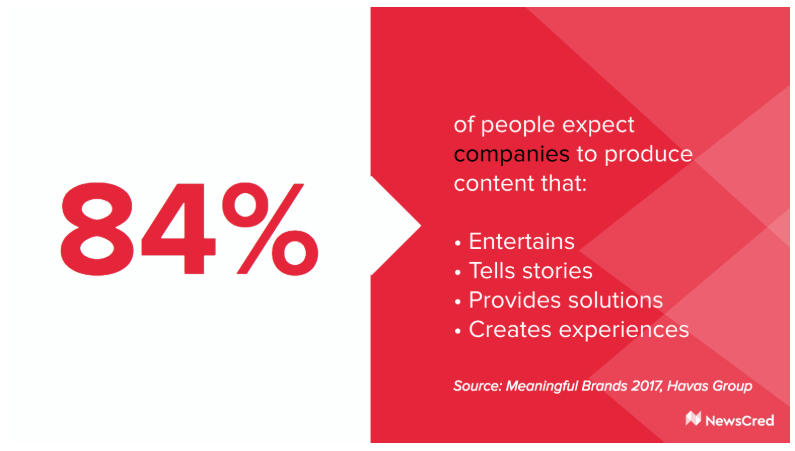
Source: http://www.meaningful-brands.com/en
There are four general purposes for creating content:
- To entertain — you want users to be delighted and amused
- To educate — you want users to be informed and have their questions answered with facts
- To persuade — you want to convince users about a disputed topic of debate
- To convert — you want users to submit a lead, book an appointment or purchase a product
Want to know how to use different kinds of content to achieve these goals?
Here are the 7 types of content and how to use them for SEO:
1. Blogging
Blogging is probably the most well-known type of digital content.
It is an especially common strategy of content marketing for small business. That’s because they’re quick and easy to write, and they’re some of the most common content you will find through Google.
List posts are a tried and proven type of blog content that can be very successful.
Blogging is one of the best types to engage and build relationships with your audience. As a secondary benefit, it can also help attract customers who are at the top of the sales funnel.
You can get people to sign up for newsletters and receive more content, and then nurture them as leads before they finally convert.
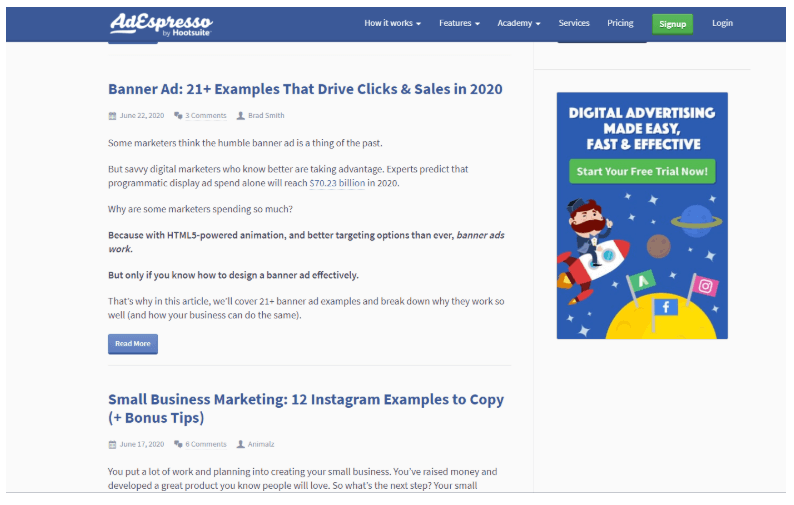
To succeed with blogging you need to maintain a regular schedule by posting new, high quality blogs. That is part of the relationship you build with an audience, so they know and expect when new content is coming and come back to your website.
Here are some tips to help you get started with a blog:
- Research long tail and question keywords that sound interesting but less relevant for the main part of your website.
- Use list posts to make your content quick and easy to read by users.
- Use a more casual, light-hearted tone and focus on making your posts engaging and entertaining.
Blog posts can help SEO by targeting more niche keywords and topics that don’t fit your main website content. They’re shorter, more specific pieces that focus as much on entertainment as they do on education and conversion.
2. Longform Content
Longform content is almost the opposite of blogging.
It is more in-depth, more formal, and more based on fact and information. You want to create longform content on the main section of your website using the hub and spoke model.
The best type of longform content is a complete and comprehensive guide covering every aspect of a specific topic. Here is a quick list of what longform content should include:
- Very high word count — they should include thousands of words, maybe even 10,000+.
- High-authority sources — you will need to back up your facts and guides with sources from top authorities people will recognize.
- Supporting visuals — break up the wall of text with supporting tables, graphs, diagrams and videos.
One great example of longform content is Wine Folly’s Beginner’s Guide to Wine.
It is a hub and spoke content model with links to tons of longform guides covering every part of wine. Despite how much information it contains, you will notice that it’s easy to read and find a particular guide that interests you.
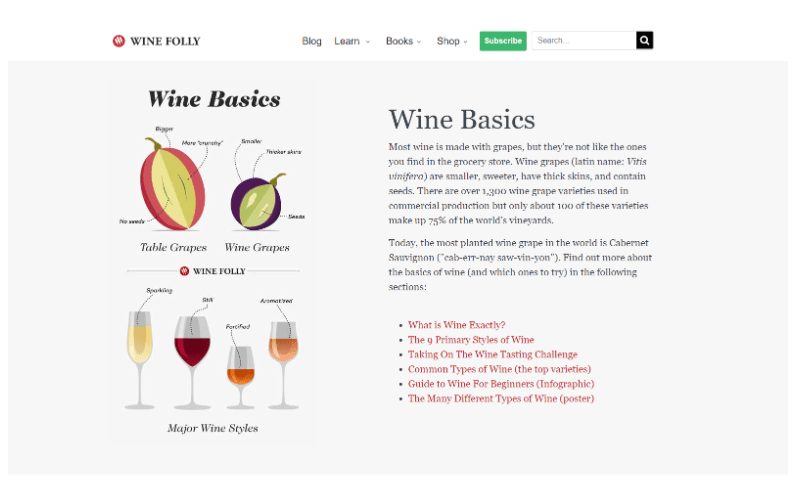
Longform content is one of the best types of SEO content. Because they are so large and comprehensive, they offer great value to readers. That’s something that Google looks for when ranking content. It also helps you cover every possible keyword within the niche.
3. Case Studies
Case studies are a great type for the persuasion purpose.
If you want to persuade someone of something, you want to back it up with data and real life success stories. Case studies use in-depth facts and data to show how a specific solution or methodology helped solve a problem.
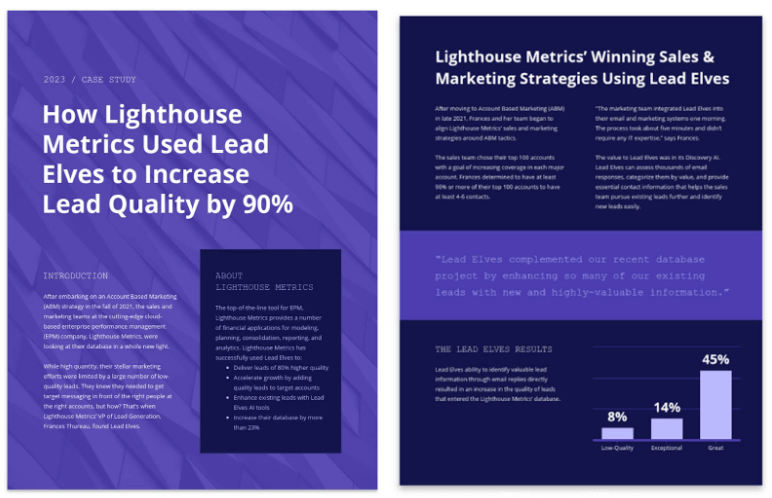
Or maybe you just want to put together some research to show off your expertise (like we did with our local search ranking case study):
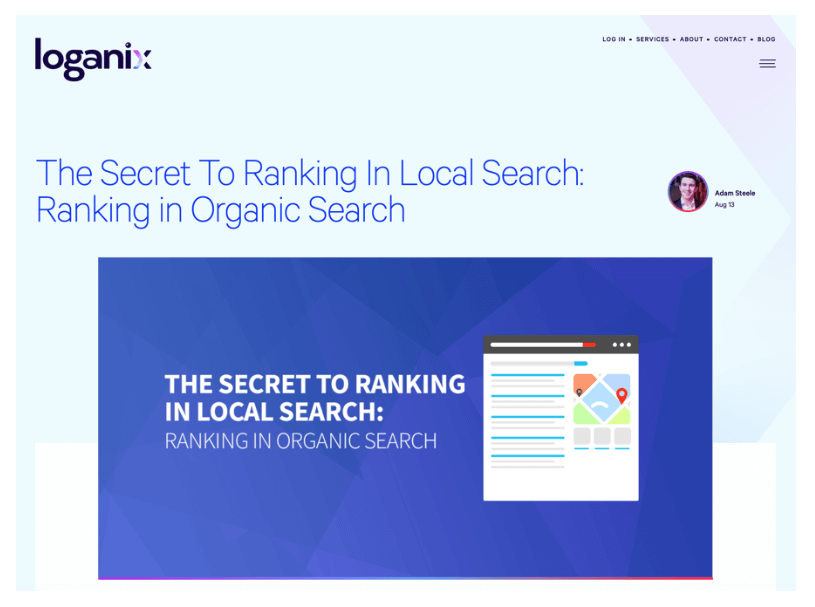
One issue that people have in writing a good case study is that they can seem boring. It’s not very exciting to present a wall of data.
However, there are some general tips to follow that can make them more engaging.
- Introduce it with a general summary of the study and its results
- Outline in more detail the problem faced and the solution presented to solve it
- Explain the methodology used when implementing the solution
- Present the results with context and an explanation of why they’re significant
Remember, you want these case studies to convince people that a strategy or solution is effective. It can be very helpful for your SEO when it comes to conversion-based content.
If people are searching for a solution, or questioning if a solution is worth it, you want them to find your case study.
4. Ebooks
Ebooks are large enough that they make longform content feel like a short blog article.
However, ebooks can be very effective lead magnets that you can use for years. They are the epitome of evergreen content that always attracts interested readers
If you want to have success with an ebook and don’t know how to write that much content, here are some tips:
- Use a freelance writer and/or editor to write the ebook for you.
- Repurpose all of the longform content you wrote on one topic and combine it into a seamless ebook.
- Start with shorter ebooks that are only five to thirty pages long.
- Link to your ebook purchase or download page from your blog or relevant content hub.
Otherwise, ebooks should follow the same purpose as longform content. They should focus mostly on educating the readers, like an ultimate guide for a niche. It should provide lots of value and information for the reader to completely cover a specific topic.
The length and value of an ebook is great for SEO by using the education aspect to drive more conversions. It can get interested customers into your sales funnel by signing up to download it. Once you convince them that you’re an authority they can trust, you can nurture them until they convert.
Remember Wine Folly’s guide to wine basics?
In that content hub they link to an ebook that is the master’s guide to wine language:
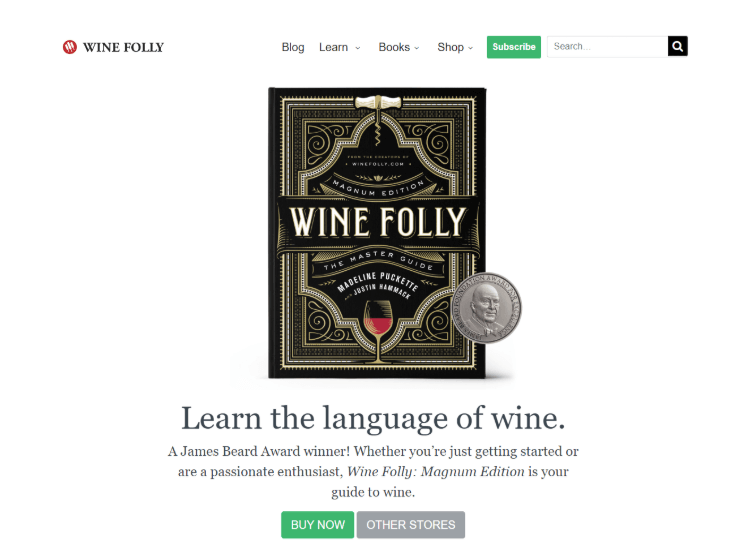
Source: https://winefolly.com/wine-folly-magnum-edition-the-master-guide-hardcover-ebook/
It acts as a step up of even more valuable and advanced information on the topic, after the longform content helped establish value and authority. The ebook then acted as a lead magnet.
5. Infographics & data viz
People love a good infographic and data visualization.
They are loaded with tons of interesting data and information, and presented into a clean design that’s easy to read. They’re a great way to combine several different types of statistics into one piece of content.
Infographics by themselves are difficult to have value from an SEO perspective, because as images Google can’t read them.
However, since people love infographics they’re a type of content that’s more likely to get shared on social media, go viral, and get lots of backlinks.
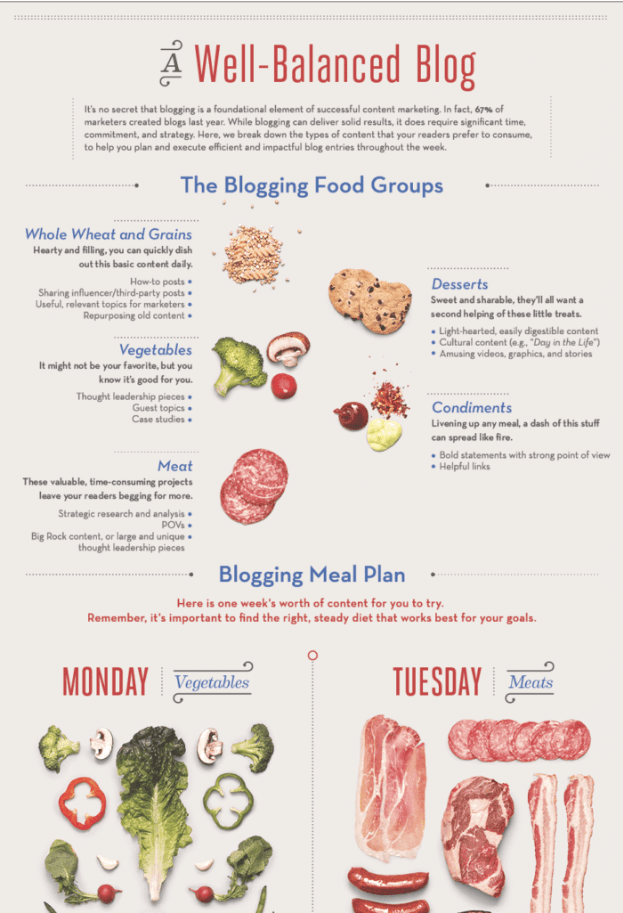
Here are some tips to create a viral infographic that search engines will still understand:
- Don’t make it too dense, use white space so each section and statistic is easy to read
- Don’t overload it with only semi-relevant stats, it should be able to tell a clear story
- Organize each statistic into its own section to keep the design clean
- Create a page for it on your blog or website with some SEO text so search engines can understand the page
6. Assets (templates, checklists, calculators etc)
Assets is a type of comment that people often search for when they need help with something.
Calculators are the perfect example for doing a useful function and attracting links:
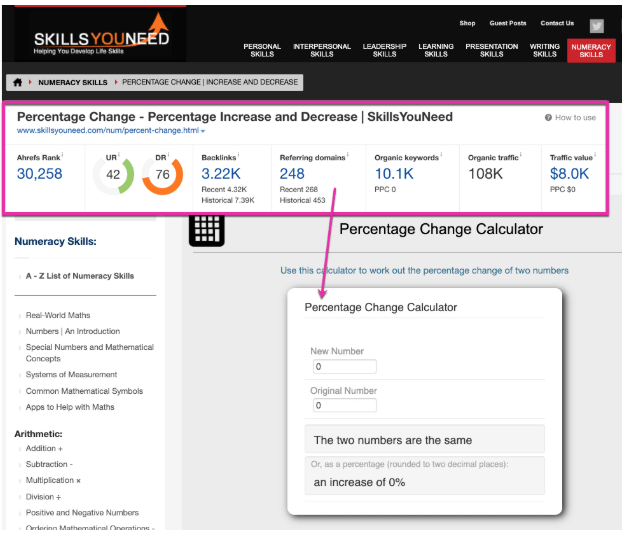
Source: https://www.skillsyouneed.com/num/percent-change.html
They could be trying to write a resume or cover letter, or find a checklist to follow when performing a task so they don’t forget anything.
If you have the resources, you can also create a tool that calculates something that most people find too complicated. It can be something like the following:
- Taxes
- Currency conversion
- Mortgage rates
- Travel plans based on distances
- Time zone differences
These assets have great SEO value as they can go viral on social media if people find them very useful.
They can also get a lot of backlinks, and rank highly on search results when someone searches for a tool to help them. For things like templates and checklists, you can make them downloadable to create a lead magnet.
7. Video
People love watching videos online. YouTube wouldn’t have 1.8 billion active users using its platform every month if they didn’t. It is a more engaging form of content that pure text articles or blogs.
It can also make it easier to digest than a wall of text for some people. This is especially the case for guides, tutorials and other similar kinds of content.
- Repurpose guide articles into videos with supporting visualization (you can use a tool like Clipchamp to quickly create video content). Consider adding an extra layer of accessibility by incorporating AI text to voice or professional voiceovers, too.
- Create videos that show how to use an item or product
- Embed videos into articles that elaborates on a specific piece of information
- Upload the videos on YouTube and share them with blog and social media posts
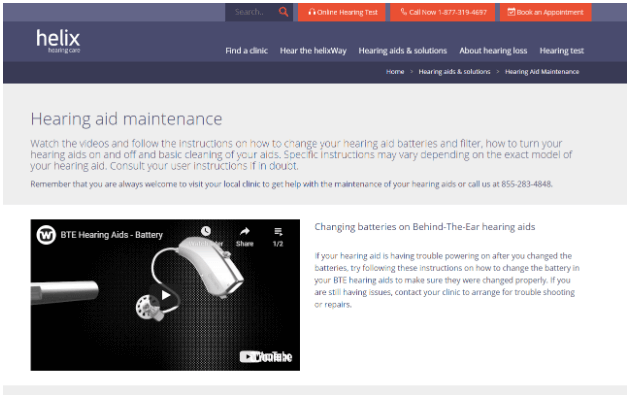
Source: https://www.helixhearingcare.ca/en-ca/hearing-aids-and-solutions/maintenance
The SEO value for video content is that people will engage with them. If someone clicks to watch a video on a page, it reduces the bounce rate of that page. Those behavioural signals count for a lot when Google ranks various pages on a topic.
Always make sure your video includes a call to action at the end. When you post them on YouTube you can add links to drive people to a conversion page. When embedded on your site, you can include a phone number or invite them to visit your website with a URL.
Summary
To have a successful content marketing campaign, you need to make use of every type of content you can.
Some are more difficult to create than others, but there are tools and freelancers to help. By using different types of content, you help make sure your campaign appeals to the broadest audience possible.
Some people are visual learners, and prefer watching a video guide than reading it. Some love facts and information, making infographics and visualizations a strong attraction.
You can also use different types of content as a lead magnet to attract more users to become customers.
Hand off the toughest tasks in SEO, PPC, and content without compromising quality
Explore ServicesWritten by Aaron Haynes on July 15, 2020
CEO and partner at Loganix, I believe in taking what you do best and sharing it with the world in the most transparent and powerful way possible. If I am not running the business, I am neck deep in client SEO.





